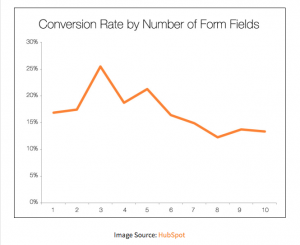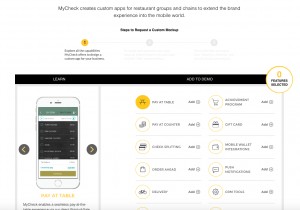
A website redesign is a great opportunity to refresh your online presence.
But don't think of a website redesign as a design task. Instead, you should start with marketing strategy and with data. During and after a redesign, you should be adding to your website, A/B testing, and mining data for new opportunities.
If you want your website to generate high returns (and do more than look pretty), here are 8 crucial tips in the form of questions you must ask.
"One of the top four priorities for 700+ CMOs is to inject data-driven insights into every marketing decision." – IBM Survey
Is the web a space that grows business for your company? Or simply awareness?
Particularly if you're in the B2B space, you have a big opportunity to generate and convert leads with your website.

But first, let's revisit the idea of a "legacy" website.
The legacy website redesign is a static brochure website. In other words, it provides information, maybe some nice photographs and design... but no opportunities to convert.
In order to decide your website's direction, ask this question: "Will we drive business leads online?" If your answer is yes, your website redesign should be focused around conversion strategy.
Do you know how well your website is performing now?
And I don't mean "vanity" metrics like website traffic, bounce rate, or time on page.
Only 16.6% of marketers use marketing analytics to inform multi-channel marketing, according to CMOSurvey.org, via HBR.org.
Instead, you should know your website's conversion rate. And that could mean different things to different businesses.
https://www.ironpaper.com/articles/how-to-improve-b2b-website-conversion-rates/
For example, a conversion could be:
Before you even touch a design tool, you should have a solid idea of "What is a conversion?" and "Whom are we converting?" for your website.
 This will help you set a goal for your website's conversion rate. Then, you can start to identify website and landing pages you'll need to help achieve this goal.
This will help you set a goal for your website's conversion rate. Then, you can start to identify website and landing pages you'll need to help achieve this goal.
Tip: For your website redesign, look at your conversion opportunities and ask: Can we simplify our form fields? There's a close relationship between conversion rate and number of form fields. Simpler is better.
This may surprise you, but good conversion rate shouldn't be based on industry benchmarks.
You know your conversion rate. Now, how can your website redesign grow your lead- and demand-generation efforts even more?
For demand generation, maybe you need to redo your navigation to be search-friendly. Or you can optimize existing pages around important keywords. Additionally, you could build on a different CMS that's hospitable to SEO.
https://www.ironpaper.com/articles/how-to-increase-lead-generation-with-a-focused-call-to-action-cta/
In order to optimize lead generation, you should put lead submission forms, calls-to-action, and content offers at the forefront.
These are the actions you should consider long before you start with design wireframes. To make informed decisions, dig into the data.
Tip: To prioritize redesign pages, start by identifying your highest trafficked pages, then optimize those for lead capture. This will also help you gather data quickly with a larger sample size.
Which efforts will generate the most return for your input?
This question is at the heart of lean, agile marketing.
Instead of focusing on big projects that would suck resources before delivering results, start with small steps. Then, then iterate from there.
This is the growth-driven design approach. It puts the focus on lean, high-performing website redesigns.
https://www.ironpaper.com/articles/benefits-of-growth-driven-design-over-traditional-web-design/
How can you get started with growth-driven design?
First, dig into your historic data to see what has brought returns for your business.
And by returns, I mean quantifiable returns: qualified leads generated, and high conversions, etc. Then, invest in those pages and tactics to start your website redesign.
Tip: Start small with your website redesign. Take it one or two pages at a time. Release a lean version of your redesign, then spend time gathering analytics and running tests.
After a testing period, you can justify adding to certain areas (or moving in a different direction).
 What opportunities does your website have to integrate technology with design?
What opportunities does your website have to integrate technology with design?
Perhaps there is a set of content or data that could be better delivered with a technology redesign.
For example, do you find yourself explaining something with lots of long content? Maybe there is a chance to gamify or visualize the concept instead.
https://www.ironpaper.com/articles/growth-driven-design-hospitality-software-company/
A website redesign shouldn't be just about a layout, photography, or color schemes.
Since the digital space offers plenty of opportunities to create apps, video databases, reporting dashboards, etc., you should find new ways to present information.
What digital tools can you incorporate to appeal to your target audience?
Investing in a website redesign takes time and resources. So to stay profitable, you'll need to track the right website metrics.
Metrics such as traffic, bounce rate, and time on page don't necessarily point to profitability.
Instead, discuss how you will measure the ROI of your website campaigns. Better metrics include:
https://www.ironpaper.com/articles/website-metrics-sales-growth/
Your website is a critical tool to engage with prospects and customers. But do you have the digital capabilities to track these people as they visit and interact?
 Many analytics tool don't go far enough to track individuals online.
Many analytics tool don't go far enough to track individuals online.
Consequently, you may need marketing automation — like HubSpot — to watch individuals as they move through your website.
https://www.ironpaper.com/articles/hubspot-funnel/
Do lead generation and data matter to your business? If so, you should think about integrating marketing automation into your website redesign.
The capability to track an individual's digital footsteps is a powerful thing. That's because it can help turn your website into a sales machine.
In other words, you identify the most engaged leads online. Then, you nurture them with relevant CTAs, content, and emails.
Only 25% of marketers are collecting customer data, according to Forbes Insights and Turn.
But what does this mean for your website redesign?
As mentioned before, you should integrate systems to capture and monitor leads into your website redesign.
https://www.ironpaper.com/articles/benefits-marketing-automation/
That means using form fields, tracked links, calls-to-action, and dynamic content that can change depending on a viewer's place in the sales funnel.
These are all big-picture objectives. But you can lay the groundwork during the planning phase of your website redesign.
You might notice with surprise that none of these questions involve a website's design.
That's because a solid website starts with strategy. Design is an integral part of the process. But it's not as important as many companies prioritize it to be.
Very little of your website redesign should start with the question, "How will that look?" Instead, you should use data to drive a results-driven experience.
Sources
IBM. (2016 February). “CMOs Need to Embrace ‘Creative Disruption’ to Build Brand Loyalty, According to IBM Study.” https://www-03.ibm.com/press/us/en/pressrelease/49098.wss
Forbes Insights and Turn. (2015 January)."Data Driven and Digitally Savvy: The Rise of the New Marketing Organization." https://www.forbes.com/forbesinsights/data_driven_and_digitally_savvy/
CMOsurvey.org and HBR.org. (2015 November). "Quantifying the Impact of Marketing Analytics." https://hbr.org/2015/11/quantifying-the-impact-of-marketing-analytics
by Jonathan Franchell, CEO of Ironpaper - For more tips and hacks: Need to remove a new line after h1 tags? Both web designers and SEO practitioners need to employ headline tags: H1, H2, H3 in several ways to improve web page structure and tag...

The marketing industry is transforming significantly due to generative AI and increasing market complexity. Gartner's prediction of a 25% decline in traditional search traffic suggests that the era of search engines is dying. AI tools, particularly...

The Crowded Arena of the IT Marketplace Updated December 2024 The Information Technology (IT) landscape is experiencing rapid growth and intensifying competition. IT spending is projected to reach nearly 5.1 trillion U.S. dollars in 2024, a...

Updated December, 2024 The field of digital marketing is evolving rapidly in response to new technology and changing buyer expectations. To help career-minded marketers, we’ve rounded up the top 10 skills needed to succeed in the field. These are...
